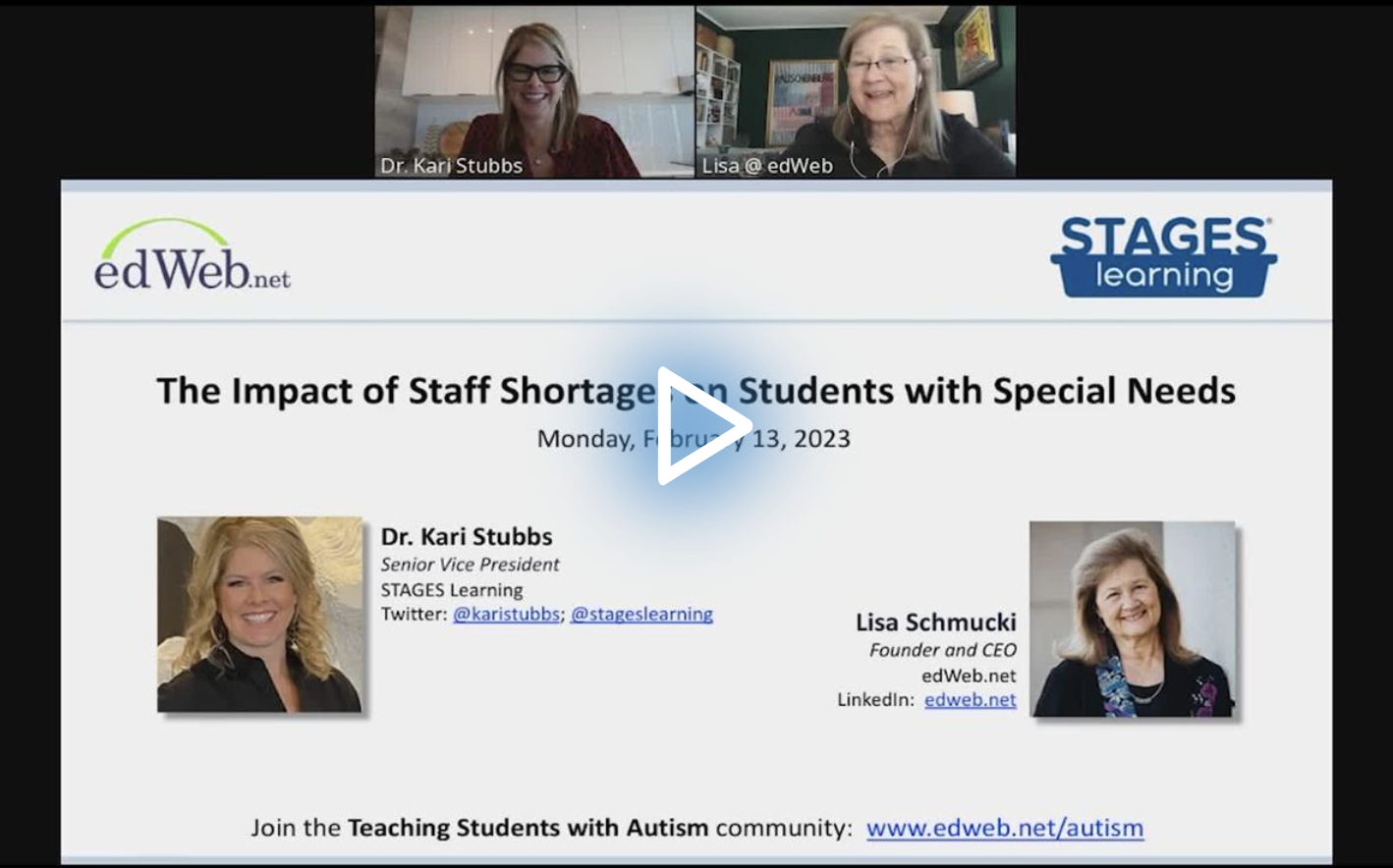Bolstering the Special Education Teaching Force
Watch the Recording Listen to the Podcast
The number of students with disabilities in U.S. schools is growing. Yet the number of teachers, paraprofessionals, and other staff qualified and prepared to teach them is declining, leaving special education learners without the services and support they need.
In the edWebinar, “The Impact of Staff Shortages on Students with Special Needs,” Dr. Kari Stubbs, Senior Vice President of STAGES Learning, and Lisa Schmucki, Founder and CEO of edWeb.net, shared data (sorted by the much-talked-about ChatGPT) highlighting why special education teaching and learning are at risk and ideas for mitigating that risk.
The Big Picture
Teacher shortages are at an all-time high. As a result, there are more positions open than there are candidates. Moreover, those applying for jobs are often unqualified. In short, the teacher pipeline is shrinking.
Turnover rates are highest among special education positions, which are also the hardest to fill. Learners with disabilities, who rely on uniquely trained and skilled educators and staff, are left without consistent interaction with teachers or paraprofessionals to support them. Special education enrollment has grown, increasing caseloads. Yet, early intervention services are upended.
The overall result? Many students are left unable to meet their instructional goals.
Key Contributors to Teacher Attrition
The data underscored myriad factors propelling teacher resignations, including difficult working conditions, burnout, high stress, low morale, growing class sizes, limited health options, workplace safety, and low pay.
Additional data indicated a need for greater funding, support, and enhanced policies to attract and retain staff. They highlighted a demand for professional development (PD), typically more available to general than special education teachers. Even when they find relevant PD (on their own!), special education teachers don’t have the time to participate because they are spread thin, and if there IS time, no substitutes can fill their slots.
Solutions in Sight
Strategic and innovative thinking can result in creative solutions to entice qualified educators into special education classrooms and help schools hold on to those already in place. Here are just a few examples of many possible efforts:
- Establishing professional learning communities, collaborative support services, job-embedded professional learning, coaching and mentorship opportunities, career development, and personalized PD, all of which have proven to reduce teacher attrition and improve school climate, culture, and working conditions.
- Improving student discipline (including PBIS and strategies for interacting with sometimes volatile special education learners).
- Enhancing administrative support for teachers.
- Offering financial incentives, including rental vouchers and mortgage assistance to tackle teacher housing challenges, scholarships to live free for a year, strategically timed bonuses, bonuses for working in high-needs schools, stipends (particularly for buying classroom supplies), and tuition and certification benefits.
- Restructuring roles with, for example, job sharing, revisiting schedules, and giving time for (or better yet, reducing) non-teaching tasks, like completing paperwork.
- Improving the ratio of staff to students and cutting down class sizes.
- Providing high-needs special education students with specialized support.
- Better educating pre-service teachers to strengthen the teacher pipeline.
Or, there’s a unique way to stem the teacher shortage: Hire former students as classroom teachers, like the Florida high school principal who incentivized his students to pursue education careers in their school. Now, 35 of his 147 classroom teachers, eight substitutes, three aides, and three secretaries are former students.
The principal pairs juniors interested in teaching with teachers in the school to give them on-the-job training. He also encourages college students to become part-time substitutes, roles that help them pay for college while preparing them for possible future school positions.
Perhaps creativity reaches its highest level. In that case, teachers might consider applying for grants to stem teacher shortages and boost special education, such as the STAGES Learning-sponsored ARIS Thrive Grant for Autism Educators. This $10,000 prize package supports teachers working with students with autism and will be awarded to four recipients to be announced during Autism Awareness Month in April.
Along with strategic initiatives to strengthen the special education teaching force is one crucial element—ensuring that teachers feel valued by providing them with the resources that drive results and their success.
Learn more about this edWeb broadcast, “The Impact of Staff Shortages on Students with Special Needs,” sponsored by STAGES® Learning.
Watch the Recording Listen to the Podcast
Join the Community
Teaching Students with Autism is a free professional learning community that provides ideas and resources for teachers working with students with autism, particularly advances in technology that can lead to significant breakthroughs in communication and learning.
For 25 years, STAGES® Learning has been dedicated to creating quality teaching tools to help educators provide the best learning opportunities for students on the autism spectrum. Since our first product, Language Builder: Picture Cards, was introduced in 1997, millions of children around the world have benefited from our products. Today, STAGES’ offerings include award-winning, photo-based teaching tools, manipulatives, games, puzzles, posters and sensory items, culminating in our recently launched complete curriculum for children with autism or other cognitive delays. STAGES’ online learning platform, releasing in time for fall 2022, will provide a digital option to ensure educators can support learners with autism and language delays in even more ways.
Blog post by Michele Israel, based on this edWebinar






Comments are closed.